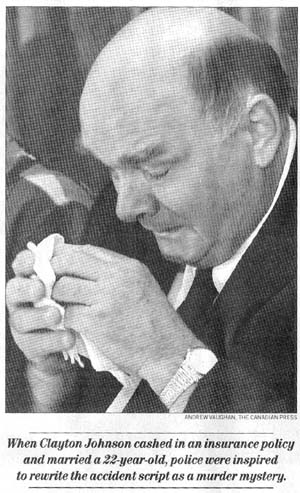

Novels that don't hang together annoy me. I'm hardly alone. We all
want stories to flow, have pieces that fit, and twists that lead to
satisfying endings.
That's what makes for good fiction; it's also what makes for convincing
criminal cases. When the story holds together, with no loose ends or
unexplainable happenings, we're apt to believe the accused "did
it." The problem is that what makes for good entertainment makes
for bad justice.
Clayton Johnson's case illustrates the point. When the unconscious body
of his wife, Janice, was found at the bottom of the basement stairs
in their home, her death was ruled a freak accident. This conclusion
was consistent with the facts; it fit Mr. Johnson's claim that he was
on his way to work at the time, and all the statements of friends and
even experts.
But when Mr. Johnson cashed a $125,000 insurance policy on his wife
and then married a 22-year old, rumours took flight, inspiring the police
to rewrite the accident script as a murder mystery.
With their earlier statements no longer fitting the new storyline, key
witnesses began changing their testimony. Reports that blood had been
found only near the body changed to recollections of blood being splattered
everywhere.
The medical examiner adapted his opinion and police called in other
pathologists who, hearing about a plot and likely struggle, re-examined
the original ruling and concluded that a deadly beating with a baseball
bat or two-by-four explained the head injuries.
Mr. Johnson was convicted of murder. He would have served a life sentence
had the Association in the Defence of the Wrongly Convicted not stepped
in to take apart the Crown's story by reviewing the initial evidence
and establishing that Janice had, indeed, died from an accidental fall.
Mr. Johnson was cleared last month of a crime that never happened. His
conviction was the result of a well-crafted story, honed over time and
spun in a convincing manner.
The work of trial lawyers is to reduce complicated scenarios to understandable
simplicities, selecting from massive evidence the tale-telling documents
and supportive testimony that make cases. Like storytellers developing
a plot and creating characters, lawyers identify a motive and use witnesses,
evidence and exhibits to flesh out the storyline. They know that emotional
drama is invariably more riveting to jurors (and even most judges) than
is dry argument.
Over and over again we've been shown how this literary strategy has
taken effect in Canadian courts. We know how Thomas Sophonow's conviction
for the murder of Barbara Stoppel came about because an unflinching
belief in his guilt controlled the investigation, causing police and
prosecutors to assemble evidence and witnesses in a fashion that would
clinch his wrongful conviction.
He, along with Guy Paul Morin, Donald Marshall, Steven Truscott, and
now Clayton Johnson, are well-known names. Their cases share a common
theme. In each, the narrative truth, as post-modern thinkers call it,
overtook the factual truth, blurring reality and distorting meaning
beyond recognition. It was the power of a damning narrative, a story
spun, elaborated by information that supported the theme, and cleansed
of disagreeing evidence, that turned these men into convicts.
It's often claimed, when innocent people are finally cleared, that it
proves our system works. We lull ourselves into believing compensation
packages make up for the false accusations, the years in prison and
the repeated failures of the court and appeal procedure to right the
errant convictions. And, generally, we accept that the wrongdoings of
those whose job it is to sort out fanciful stories from factual history
can be dismissed as honest mistakes.
While we hold the accused accountable for every discrepancy, inaccuracy
or unlikable trait, we somehow see fit to let the police and the prosecutors
off with a simple admonition to "do better next time."
It's not often that we hear of reprimands such as the one voiced last
week by Justice Ian Nordheimer of Ontario's Superior Court of Justice.
In finding Toronto Police Const. Keith Davis not guilty of sexual assault,
he described the testimony of the women who claimed he'd raped them
as clearly not believable, and he criticized the provincial Attorney
General's office for having put this innocent man through the ordeal
of a trial. Perhaps the prosecutor in this case will be more cautious
next time, but he's just as likely to shrug off the momentary embarrassment
and concentrate on winning the next one.
Crowns are bestowed with such generous immunity that they have no reason
to fear. Even when investigations are shown to be sloppy, tainted witnesses
are made to look pure, evidence that's damning to their case goes missing,
it's all seen as part of the job. Rarely do they even bother to apologize.
And it's almost unheard of for them to pay.
It happened once last year when the Supreme Court of Canada ordered
Quebec's Attorney General's office to pay $1.1 million in damages to
Benoit Proulx. He had been wrongly convicted for the murder of his ex-girlfriend
by a prosecution storyline that portrayed him as a jealous lover/killer.
The exposed actions of the Crown would sicken virtually any of us. Yet
even in this case, the court was sharply divided in its opinion, with
the minority expressing indignation that a prosecutor should be held
accountable-after all there was nothing to prove he didn't honestly
believe the story he told.
"Truth," says fantasy writer Ursula K. LeGuin, "is a
matter of the imagination." Casting aside reality may be fine if
you're an author of fiction. But one wonders just how many more wrongful
convictions we'll tolerate before it occurs to us that it's not acceptable
to tell stories that pervert justice.
tanadineen.com
@ Dr.Tana
Dineen
1998-2007
by
Dr. Tana Dineen, special columnist,
